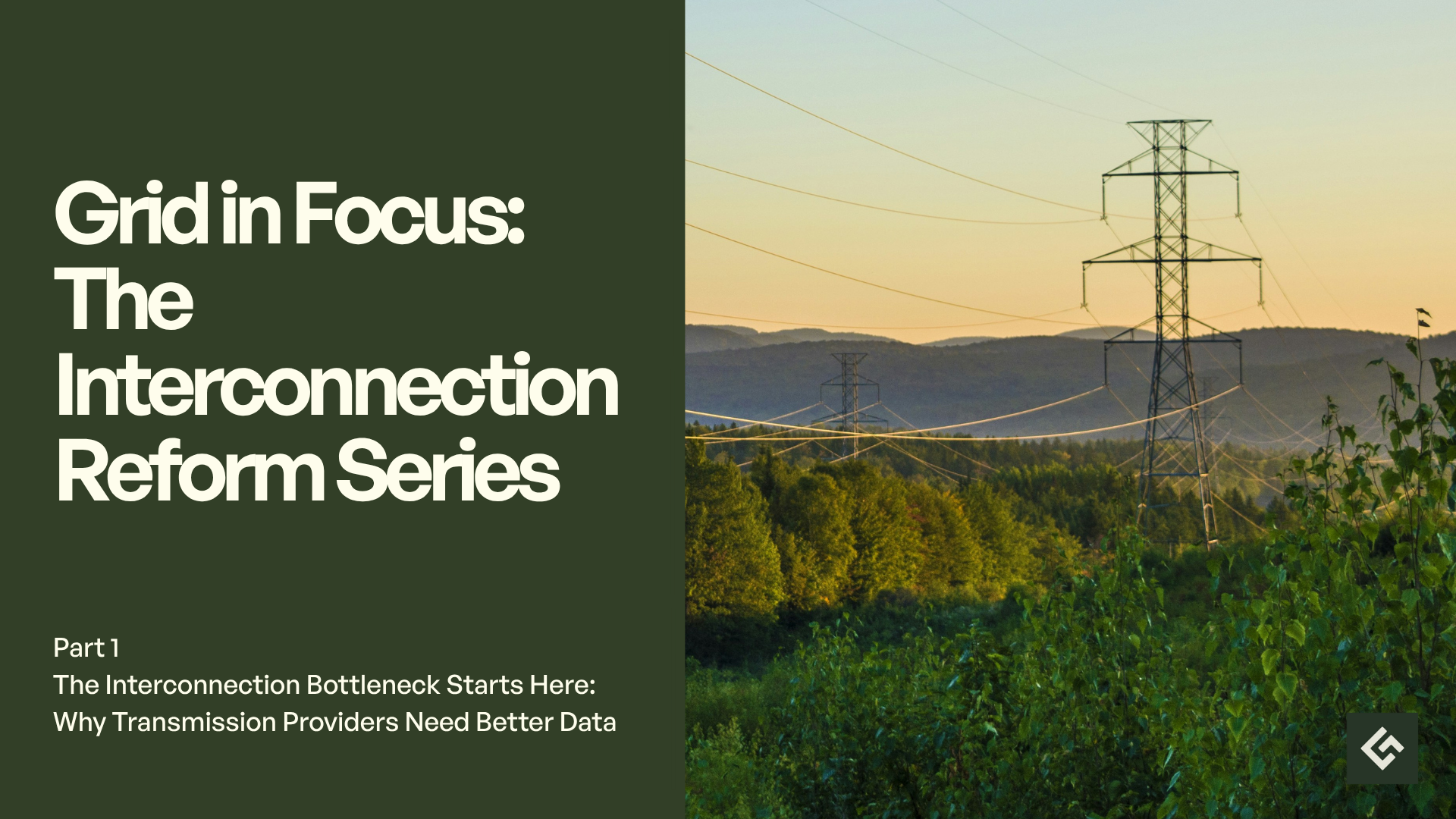Grid in Focus: The Interconnection Reform Series - Part 1: The Interconnection Bottleneck Starts Here
July 23, 2025
Grid in Focus: The Interconnection Reform Series
Grid in Focus: The Interconnection Reform Series explores how the interconnection process can evolve from a regulatory bottleneck into a collaborative, data-driven factory. By viewing interconnection through the lenses of each key stakeholder—transmission providers, developers, RTOs/ISOs, VIUs, and policymakers—we reveal the structural changes needed to meet the demands of the modern grid and unlock energy potential.

Part 1: The Interconnection Bottleneck Starts Here: Why Transmission Providers Need Better Data
Transmission planning has become one of the highest-stakes challenges in the energy transition. As the National Renewable Energy Laboratory (NREL) notes, "Across all the different scenarios of the U.S. power system we looked at, expanding transmission—sometimes significantly—is a win-win-win," said NREL Senior Researcher Trieu Mai. "We see major cost savings, substantial decarbonization, and a reliable power grid" (NREL, 2024 National Transmission Planning Study).
While developers are racing to bring new energy online, transmission providers (TPs) and RTOs are grappling with a more fundamental issue: the pace of project retirement is outpacing viable project interconnection. According to the U.S. Energy Information Administration (EIA), 62 gigawatts (GW) of electric generating capacity are scheduled to retire in the United States from 2024 through 2027—the highest planned retirement total in any four-year period on record (EIA, March 2024). Yet interconnection queues across the U.S. exceed 2,600 GW—more than double the existing grid capacity—and many queued projects may never be built due to long delays and speculative filings.
Despite reform efforts, queues are still long—and the grid isn’t getting the reliability it needs.
So what’s really going wrong?
We believe it’s not just a process problem. It’s a data problem.
The Value Transmission Providers Are Missing
When a transmission provider evaluates a new interconnection request, it must answer a critical question: Can this resource improve system reliability within the footprint we manage?
But today's application processes often fall short. Developers lack visibility into:
- What’s already under construction or in the queue
- What approvals look like across different TPs
- Where congestion, load pockets, or redundancy needs exist
- How their proposal aligns with long-range transmission plans
This lack of insight leads to speculative applications, bloated queues, and poor resource-to-grid fit. Transmission providers, in turn, are left evaluating a sea of proposals that may never succeed—draining time, attention, and staff bandwidth from meaningful grid improvements.
A Better Future: Data-Driven Interconnection
Imagine a system where:
- Developers can view data from Transmission Owners (TOs) and Transmission Providers (TPs) perspectives, multimodal grid overlays, and current queue data before submitting.
- RTOs could assess interconnection proposals through geographic and topographic context, not just spreadsheet fields.
- Transmission providers can see which proposals align with long-term planning, state-level economic goals, and grid reliability objectives.
This isn’t a far-off fantasy—it’s a data model away.
We’re envisioning a role-based, single-sign-on platform that gives each participant in the interconnection process the views and tools they need to make better decisions, faster. Not just form submissions—but decision-ready insights.
The Factory Model for Transmission Efficiency
Our approach at GridUnity is inspired by a simple but powerful idea: interconnection needs to become a factory, not a maze.
That means:
- Mapping the personas and journey paths of developers, TPs, TOs, vertically integrated utilities, and RTO staff
- Providing each one with self-service insights and validation tools
- Allowing proactive data exploration—not just reactive process steps
When done right, this factory approach doesn’t just speed up applications. It improves the quality of those applications. And that, in turn, leads to more successful projects—and a resilient, more reliable grid.
Use Case: A TO reviews incoming queue applications aligned to long-term plans and flags redundancies in real-time, reducing false positives before study begins.
What’s Next
In upcoming posts, we’ll explore the perspectives of each stakeholder in the interconnection lifecycle:
- Developers and how better data can reduce speculative applications
- RTOs/ISOs and how platform design can reduce decision ambiguity
- Vertically integrated utilities and their evolving role in regional grid planning
Because the energy transition doesn’t just need more generation.
It needs better interconnection.
Want to learn more about how to modernize your interconnection strategy?
Request a demo to see how GridUnity can help.

By Tom Coons, VP of Customer Experience, GridUnity
Connect on LinkedIn
Tom brings more than 20 years of leadership experience in energy and financial services, with a proven ability to drive enterprise agility, digital transformation, and customer-first strategy. He leads GridUnity’s Customer Success and Professional Services teams, guiding clients through implementation and beyond to maximize value, streamline interconnection, and unlock scalable innovation.

Streamline Interconnection for Transmission & Distribution
GridUnity’s technology reduces processing times for both transmission and distribution, accelerating interconnection approvals and infrastructure readiness. Whether you're managing large-scale transmission projects or streamlining distribution generation and load applications, our platform ensures efficiency, compliance, and transparency.
